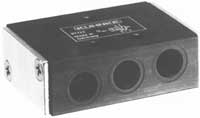Understanding Basic Pneumatic Valve Functionality
Taking the time to understand pneumatic valve functionality will save your business time and money. Below, we will go over options for identifying a valve’s functionality.
Pneumatic valves are typically created with three port numbers: 3, 4, and 5. 3-port valves are considered 3-way valves that can control a single cylinder port. Valves with 4 ports can control two-cylinder ports with the help of a single common exhaust port. 5-port variants allow for individual exhaust ports. Each of the three ports come as either push-to-connect or threaded, which defines connection types.
Besides the number of ports, it is also essential to understand the amount of valve positions that are needed. The most commonly used valve positions come in two or three positions. Each position type offers users specific directional flow paths. For a two-position miniature solenoid valve, one or two solenoids and a spring are used to shift valves. Three-position valves have a neutral state that defines operations during power-down situations. Two solenoids must be used when shifting a three-position solenoid valve
Pneumatic Valves
Determining the functionality of directional controls is also crucial for purchasing and using pneumatic valves. When using four or five-port position pneumatic valves, compressed air flows out of one cylinder and exhaust flows from the other cylinder port. Three-port valves, with two positions, have functional options that are typically closed (NC) or opened (NO). A three-position valve is defined by the neutral position of the valve when power is off. When using this type of valve, there are three options to choose from: cylinder port exhaust, all ports closed, or cylinder port pressurized.
Related Reading:
- Air Preparation and Pneumatic Valves
The purpose of pressure regulation in a pneumatic system is to limit the downstream pressure by blocking pressure at the inlet. These devices are necessary for the air preparation stage, while also being able to control motors and cylinders.
- Safety While Using Pneumatic Systems and Tools
- Considerations for Pneumatic Valves


- Ellis/Kuhnke Controls
132 Lewis Street Unit A-2, Eatontown, N.J. 07724
Phone: 1-800-221-0714
Fax: 732-291-8154
Email: Info@ekci.com
- Home Pneumatic Controls Technical Info CAD Drawings Contact Us Pneumatic Timers Blog Site Map
